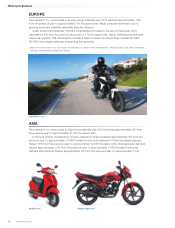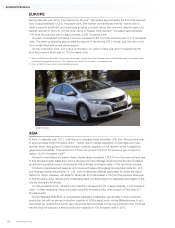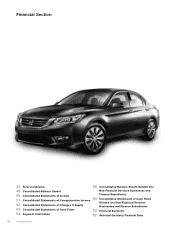Honda 2013 Annual Report Download - page 27
Download and view the complete annual report
Please find page 27 of the 2013 Honda annual report below. You can navigate through the pages in the report by either clicking on the pages listed below, or by using the keyword search tool below to find specific information within the annual report.2. Honda’s hedging of currency and interest rate risk exposes Honda to other risks
Although it is impossible to hedge against all currency or interest rate risks, Honda uses derivative
financial instruments in order to reduce the substantial effects of currency fluctuations and interest
rate exposure on our cash flows and financial condition. These instruments include foreign currency
forward contracts, currency swap agreements and currency option contracts, as well as interest rate
swap agreements. Honda has entered into, and expects to continue to enter into, such hedging
arrangements. As with all hedging instruments, there are risks associated with the use of such instru-
ments. While limiting to some degree our risk fluctuations in currency exchange and interest rates by
utilizing such hedging instruments, Honda potentially forgoes benefits that might result from other
fluctuations in currency exchange and interest rates. Honda is also exposed to the risk that its
counterparties to hedging contracts will default on their obligations. Honda manages exposure to
counterparty credit risk by limiting the counterparties to major international banks and financial
institutions meeting established credit guidelines. However, any default by such counterparties might
have an adverse effect on Honda.
Legal and Regulatory Risks
1. The automobile, motorcycle and power product industries are subject to extensive environmental and
other governmental regulations, including with respect to global climate changes
Regulations regarding vehicle emission levels, fuel economy, noise and safety and noxious sub-
stances, as well as levels of pollutants from production plants, are extensive within the automobile,
motorcycle and power product industries. These regulations are subject to change, and are often
made more restrictive, particularly in recent years, due to an increasing concern with respect to
possible global climate changes. The costs to comply with these regulations can be significant to
Honda’s operations.
2. Honda is reliant on the protection and preservation of its intellectual property
Honda owns or otherwise has rights in a number of patents and trademarks relating to the products
it manufactures, which have been obtained over a period of years. These patents and trademarks
have been of value in the growth of Honda’s business and may continue to be of value in the future.
Honda does not regard any of its businesses as being dependent upon any single patent or related
group of patents. However, an inability to protect this intellectual property generally, or the illegal
infringement of some or a large group of Honda’s intellectual property rights, would have an adverse
effect on Honda’s operations.
3. Honda is subject to legal proceedings
Honda is and could be subject to suits, investigations and proceedings under relevant laws and
regulations of various jurisdictions. A negative outcome in any of the legal proceedings pending
against Honda could adversely affect Honda’s business, financial condition or results of operations.
Honda Motor Co., Ltd. 25
























